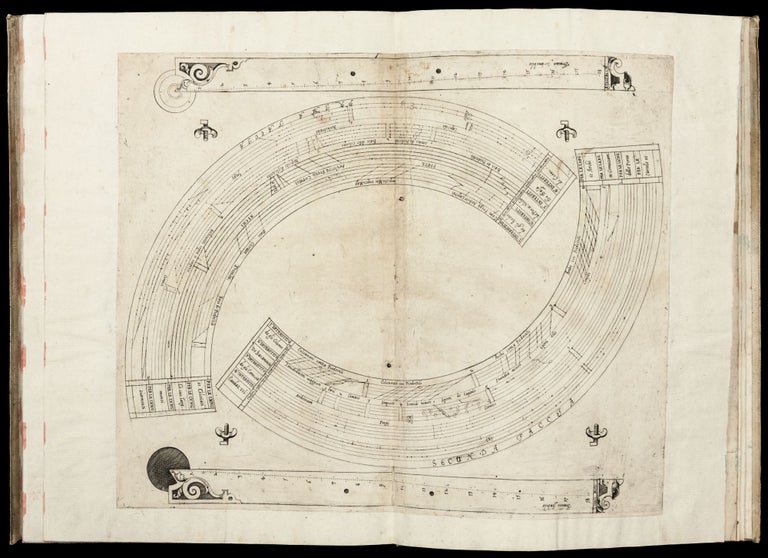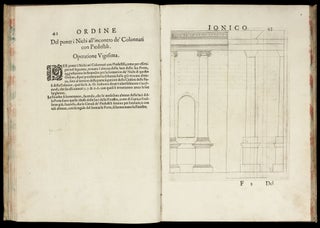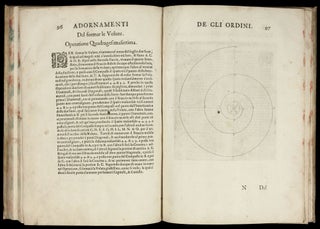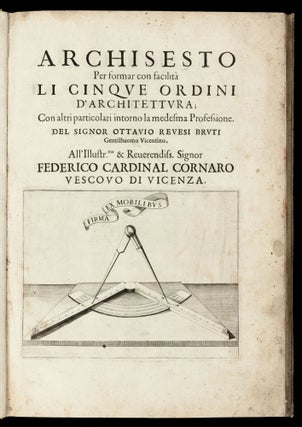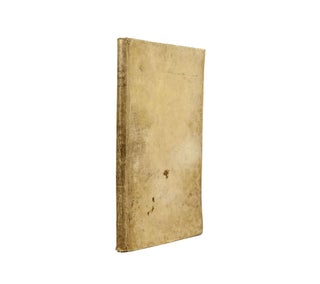Archisesto per formar con facilità li cinque ordini d’architettura.
Folio [33.5 x 23.0 cm], (4) ff, 100 pp., with (1) engraved vignette on title page, (1) double-page engraving of the instrument (here mounted on paper), (49) engravings in the text (48 of which are full page), (1) full-page engraving (a baluster) at end of volume, woodcut headpieces, tailpieces, and initials. Bound in contemporary vellum, title in manuscript on spine, red and blue mottled edges, bookplate of T. Besterman and book label of E. Tomash inside upper cover. Minor rubbing, handsoiling and edge wear to spine and boards. Occasional minor generally marginal toning and staining, old paper reinforcements to fore edge of p.l. 1, p.l. 2, and f. M3, a few contemporary annotations, plate at p. 21 printed upside down. In nice condition overall. Rare first and only edition, first issue, of the Vicenza architect Ottavio Revesi Bruti’s (c. 1585-1648) richly illustrated folio describing his new instrument for accurately constructing scale drawings of the architectural orders without reliance on laborious calculations, a boon both for practical architects eager to avoid difficult mathematics on the building site and for learned theorists who wished to make drafts from classical models at home. The nobleman Revesi Bruti, “an undisputed protagonist of the very early phase of post-Palladian architecture in Vicenza” (L. Trevisan, DBI), was educated at the city’s famed Accademia Olimpica, where he absorbed the teachings of the local architectural heroes Andrea Palladio (1508-80) and Vincenzo Scamozzi (1548-1616). Revesi Bruti here thus not only provides readers with the best, most current architectural types, but also an instrument for reproducing and further disseminating these models. Revesi Bruti’s instrument, which he calls the ‘archisesto’ or ‘architectural compass’, is fundamentally an adaptation of Galileo’s 1598 proportional compass to the automatic scaling of architectural drawing, with markings on the face of the instrument indicating how to reproduce each element (architrave, cornice, base, capital, etc.) of the Tuscan, Doric, Ionic, Composite and Corinthian orders. Full-page architectural engravings with facing-page text treat each if these elements in detail. Revesi Bruti notes that the archisesto could also be used for pantographic scaling in the disciplines of geometry, arithmetic, and music, and to design “temples, theaters, amphitheaters, circuses, towers, pyramids, colossuses, mausoleums, and so forth” (p.l. 3r). In a prefatory section titled “Brief Remarks on the Construction and Marking of the Instrument,” Revese Bruto suggests that the reader could cut out the components from the book’s engraving of the archisesto and simply mount them on board or that a sturdier version could be built of “brass from Germany” (p.l. 4r). In the second issue of the book, he inserts at the end of this section a line stating that an archisesto in metal could be found in the Piazza della Signoria of Padua at the shop of a certain Aquilin Serena Giovine. The Archisesto per formar con facilità li cinque ordini d’architettura is the only book Revesi Bruti (also known as Revese Bruto or Ottavio Orefici) published, although he is said to have authored treatises on mathematics and theater history. His activity as a practicing architect is much debated, and he is variously credited with having produced the designs for the portal of the Teatro Olimpico of Vicenza, the arch at the Campo Marzo of Vicenza (destroyed 1938) and several buildings in his native Brendola (see Pippi and Trevisan for Revesi Bruti’s biography and buildings attributed and misattributed to him). Revesi Bruti’s treatise received renewed attention in the 18th-century in relation to the Neo-Palladian movement in England when it was translated by Thomas Malie as A New and Accurate Method of Delineating all the Parts of the Different Orders in Architecture (1737) and discussed extensively by J. J. Kirby in The Perspective of Architecture (1761). The present example of the Archisesto per formar is the first issue (of two) of the first and only edition of the work. In the second issue, the type was reset and altered slightly in the preliminary leaves, quires A & B, and a few other text leaves, and letters and numbers were added to a few of the engraved plates (e.g., at pp. 21, 59, and 61). OCLC locates U.S. examples at the Getty, National Gallery of Art, Harvard, Columbia, Washington St., Penn St., Penn, Ohio St., and the Metropolitan Museum of Art. * Tomash & Williams R77; Berlin Kat. 2612; BL/STC 17th-century Italian Books II, p. 742; Cicognara 631; RIBA III, 2739; Riccardi I(ii) 351; Vinciana Aut. Ital. del ‘600 4396. L. Puppi, “Profilo di Ottavio Revese Bruti.” Bollettino del Centro Internazionale di Studi di Architettura Andrea Palladio, vol. 3 (1961), pp. 121-131; L. Trevisan, “Revese Bruto, Ottavio,” Dizionario Biografico degli Italiani, vol. 87 (2016).
Sold

